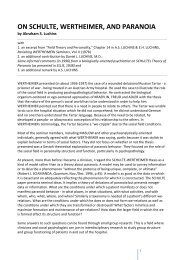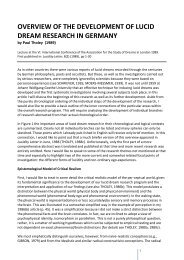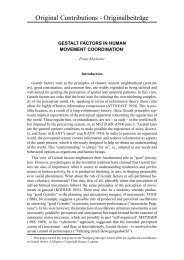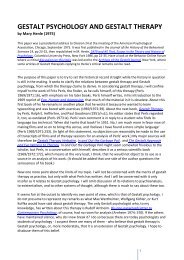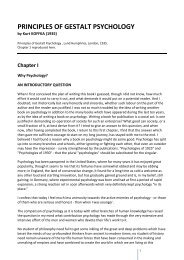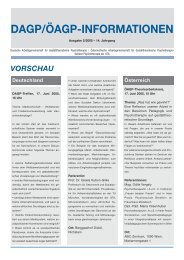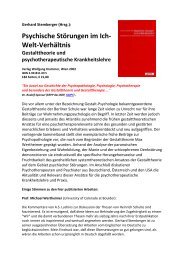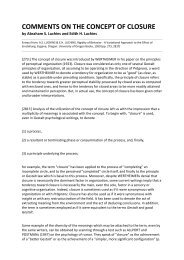pdf-Download - Society for Gestalt Theory and its Applications (GTA)
pdf-Download - Society for Gestalt Theory and its Applications (GTA)
pdf-Download - Society for Gestalt Theory and its Applications (GTA)
Create successful ePaper yourself
Turn your PDF publications into a flip-book with our unique Google optimized e-Paper software.
description of experience. In this contention they are expressing a taste of scientific logic <strong>and</strong> again it is the future thatwill decide whether their preferences will be fruitful enough to persist. (BORING, 1942, p. 90)It is now the future, almost six decades later. What does the reader think has been shown aboutwhether the brain is a field with dynamic <strong>for</strong>ces, or a network of connections, <strong>and</strong> whetherisomophism can be meaningful between neural <strong>and</strong> non-neural events <strong>and</strong> need not be limited torelationships between neural events?ISOMORPHISM, PHENOMENOLOGY, AND BEYOND PHENOMENOLOGYSome, but not all, of the sources we cited mentioned WERTHEIMER's physiological short-circuithypothesis <strong>for</strong> apparent movement. Most of the citations referred only to KÖHLER s principle ofisomorphism, usually described as psychophysical isomorphism.WERTHEIMER would probably not be troubled that this principle was associated with KÖHLER. Itseemed that initially both WERTHEIMER <strong>and</strong> KÖHLER were interested in the physiological orpsychophysiological field. But subsequently WERTHEIMER became more concerned with thephenomenal <strong>and</strong> geographical fields. In his publications, aside from his classical study on apparentmovement, he did not introduce a physiological model (but sought <strong>for</strong> a mathematical model ofisomorphism). However, he did not entirely overlook physiology. In a 1937 lecture he talked aboutthe "old view" which held that psychology <strong>and</strong> physiology (that is, psychological <strong>and</strong> physiologicalevents) are similar because of associations due to past experience; the "new view" held thatpsychology <strong>and</strong> physiology are similar because of similar <strong>Gestalt</strong> qualities. He also said that he <strong>and</strong>KÖHLER had different <strong>for</strong>mulations of isomorphism. He wrote: How stimulation is <strong>and</strong> how it is inthe brain (K); how behaviour is <strong>and</strong> how it appears (W).We think these words can be clarified by using the letters <strong>and</strong> schema that KOFFKA suggested. LetB represent the behavioural field, G the geographical (or physical) field, <strong>and</strong> P the physiologicalfield. Consider the schema BP(G. His <strong>for</strong>mulation of the principle of isomorphism as "characteristicaspects of the physiological processes are also characteristic aspects of the correspondingconscious processes" (1935, p. 109) focused on the relationship between B <strong>and</strong> P, which he calledcrucial (p. 53). It might be said that WERTHEIMER focused on the relationships between thebehavioural <strong>and</strong> the geographical world, between B <strong>and</strong> G, whereas KÖHLER focused on therelationship between the behavioural <strong>and</strong> the physiological field, between B <strong>and</strong> P. Bothapparently recognized that it sometimes happens that the behavioural field, the geographicalfield, <strong>and</strong> the physiological or brain field may be isomorphic, may have similar molarcharacteristics.WERTHEIMER stated that isomorphism did not always hold <strong>and</strong> that the conditions under which itdid or did not hold called <strong>for</strong> research. WERTHEIMER's thesis called <strong>for</strong> empirical research, <strong>for</strong> newways to deal with the question of why things look the way they do. WERTHEIMER also broadenedthe concept of isomorphism beyond the perception of things to the perception of emotions,movements, language, <strong>and</strong> other symbols. KÖHLER considered such ideas in his 1938 book onvalues, which frequently referred to isomorphism.It seems that there is more than one concept of isomorphism in <strong>Gestalt</strong> theory to judge byWERTHEIMER's distiction between his <strong>and</strong> KÖHLER's <strong>for</strong>mulations. {We are reminded of thedistinction drawn by GRELLING & OPPENHEIM (1991, 1988, original 1939) between twoconceptions of <strong>Gestalt</strong>: <strong>Gestalt</strong> as configuration, shape or <strong>for</strong>m, contrasted with <strong>Gestalt</strong> as"functional whole."]. Neither KOFFKA, KÖHLER nor WERTHEIMER claimed to have introduced theconcept of isomorphism in <strong>Gestalt</strong> theory. Nor is it easy to distinguish clearly between thecontributions of one or the other of the founders. We are reminded of what Giovanni B. VICARIO(1994) wrote in a tribute to his mentor, Gaetano KANIZSA:16



